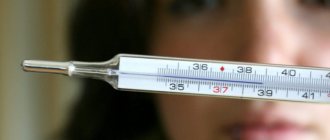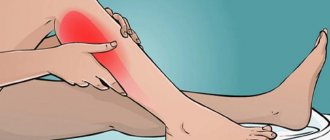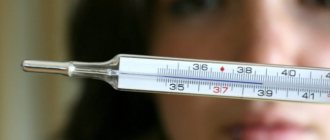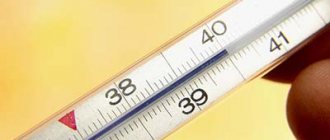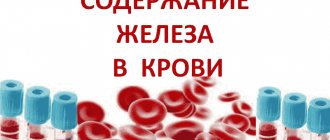A person is able to maintain body temperature in a relatively constant range from 36 to 37.1 ° C, despite the fact that he experiences many environmental factors and the influence of thousands of processes directly inside the body. Thanks to daily biorhythms, the temperature in the morning is lower, and in the evening, on the contrary, it rises. Changes in weather conditions, indoor air, physical activity, illness - all this can change body temperature both above and below the mentioned indicators. This process, reaching critical values, can lead to a life-threatening condition, so it is necessary to know at what temperature a person dies.
Pathological temperatures
At low temperatures (hypothermia), people die due to extreme hypothermia of the body and all organs. With increased (hyperthermia), they die not from “overheating,” but from the disease or factors that caused its rise.
Comparison of pathological temperatures.
| Hyperthermia | Hypothermia |
| Subfebrile – 37.2 – 37.9 °C. | Initial - 35 - 32 °C. |
| Moderately elevated – 38.0-38.9 °C. | Average - 31.9 - 27 °C. |
| High – 39-39.9 °C. | Severe – below 26.9 °C. |
| Excessively high – 40 °C and above, which includes, in particular, hyperpyretic (above 41 °C), which is the most dangerous. | Extremely severe – below 22°C. |
Reduced temperature during pregnancy
Just as with adrenal cortex dysfunction, hypothermia during pregnancy, especially in the early stages, is associated with hormonal imbalance. In pregnant women, this condition is quite normal, since in this state the woman’s body undergoes significant changes, and the hormonal balance is rearranged. During a calm pregnancy, body temperature will return to normal on its own, since it is not associated with functional disorders.
If the temperature drops significantly in pregnant women, when it is less than 35.7 degrees, you should consult a specialist. If the temperature drops slightly, just lie down or sit down and allow yourself to rest.
You can warm up with a warm drink or clothing. The less a pregnant woman worries and worries, the easier the process of bearing a child will be.
At what body temperature does a person die?
When it drops to 25°C, the condition is regarded as life-threatening, certain near-death sensations occur, and at temperatures below 20°C, death occurs. Upon reaching 42.5°C, the brain gradually dies irreversibly, and above 45°C, organ cells are destroyed.
Hyperthermia - overheating of the body
This condition occurs during heat or sunstroke, when there is a sudden and intense rise in body temperature, from which a person can die. This form of hyperthermia can reach temperatures of about 42°C in a matter of minutes. This condition occurs either from too much heat, which presses on a person from all sides, or from the body’s inability to quickly adapt to high environmental temperatures.
Heatstroke
It can happen in a fire, while working in “hot” shops and other industries, etc. A patient exposed to heat stroke dies from a lack of cardiac function, respiratory arrest and intoxication (due to the accumulation of ammonia released due to the destruction of blood cells and microcirculation disorders) in 30% of cases. The body temperature during such a death depends on the conditions where the deceased was found.
Sunstroke
The direct action of sunlight and its radiation can dramatically change body temperature. Due to the infrared portion of the total solar radiation, a person warms up both the upper layers of the skin and the deeper ones, right down to the organs and tissues. Due to this radiation heat, the entire body, including the brain, overheats. This is especially dangerous because... It houses an important thermoregulator of body temperature. During sunstroke, this center is switched off from the body's work, leading to its gradual death.
Important! If you suspect sunstroke or heatstroke, call an ambulance immediately!
Diseases
“Internal” hyperthermia, or, as it is also called, toxic, is formed in the body with a rapid increase in heat production inside the human body, when sweating and other regulatory mechanisms cannot cope with its excess. There are quite a lot of such reasons:
- hemorrhages, stroke, traumatic brain injury, when the thermoregulatory center of the brain is affected;
- mental disorders: psychotrauma, hysterical reaction, mental illness;
- difficulty in heat transfer during training and other physical activities in thermal clothing;
- diseases of the thyroid gland and adrenal glands;
- infectious diseases;
- decreased sweating and vascular spasm in the skin;
- tumors;
- inflammatory diseases of the abdominal and retroperitoneal cavities, respiratory tract, ENT organs;
- abscesses and phlegmons.
Overheating of the body entails disruption of blood flow, as a result of which the latter is reduced. Heat ceases to be adequately transferred from organs to the surface of the skin. Under the influence of high temperatures and stress, the body forms and releases many enzymes and hormones into the blood, which, due to reduced blood flow, have a toxic effect on the heart muscle. When the heart overheats, it is not able to satisfy the given needs, and circulatory failure develops. At 42 - 43°C, breathing stops and the victim dies.
Hypothermia - hypothermia
When the body is hypothermic, it is important to know at what air temperatures a person dies and what processes occur in the body during hypothermia.
Factors leading to death from low body temperature
The following external causes that lead to hypothermia are distinguished:
- high air humidity leads to reduced thermal insulation;
- strong wind quickly cools the body;
- damp, wet, cold clothes reduce thermal insulation properties;
- getting into cold water means a sudden loss of heat;
- alcohol intoxication, fasting, injury or extreme conditions can reduce the body's defenses, making it more sensitive to temperature changes;
- dehydration;
- loss of consciousness at low temperatures.
“Internal” hypothermia is a rarer phenomenon, but, nevertheless, such ailments occur only in conditions of low ambient temperature. It occurs only in conjunction with “external” hypothermia. Most often this condition occurs when:
- extensive muscle paralysis;
- muscle dystrophy;
- adrenal insufficiency;
- extreme exhaustion of the body.
The dying process
During hypothermia, when the body temperature drops to 36°C, the muscles of the neck and shoulder girdle first tense up. At the same time, the thermoregulation center narrows the capillaries in the skin. Due to the reduced blood flow, it feels like your arms and legs are cramping. After about an hour, the body temperature drops to 35°C and chills appear, because The body tries to release heat during muscle contractions and movements.
After an hour, enzymes in the brain begin to reduce their productivity by up to 5% for each reduced degree from normal. When reaching 34°C, brain neurons show the first signs of degradation - a person loses memory and is forgotten, because... the body is no longer able to warm itself. Heat loss increases, and at 32°C confusion, apathy, and drowsiness occur.
At temperatures below 28°C, arrhythmia occurs, a person lacks oxygen, resulting in hallucinations. Below 25°C, the rhythm of the heart and breathing is disrupted, consciousness becomes confused, and coordination is impaired. Death occurs when body temperature drops to 20°C. In this case, consciousness is no longer present, pulmonary edema forms, the heart stops and the person dies.
Should we panic?
A high temperature without signs of a cold in an adult in the vast majority of cases is pathogenic in nature. Often a sharp increase in body temperature without visible symptoms indicates the development of colds. During this period, the body fights viruses, and most likely, cold symptoms will “show” themselves after a couple of days.
Also, a high temperature without signs of a cold may indicate:
- food poisoning;
- infection in the body;
- disruption of the cardiovascular system;
- insufficient amount of iron in the body;
- development of allergies in the body;
- inflammatory process.
Temperature may also rise due to injuries. Should I worry in this case? It is impossible to get a definite answer. But it’s better to play it safe, since a high temperature that develops after an injury or abrasion may indicate the start of an inflammatory process or blood poisoning.
A temporary increase in high temperature can develop against the background of hormonal changes. This is especially common in women who have given birth during lactation.
To understand whether you need a doctor's help, observe your body. If the temperature without cold symptoms lasts for 24 hours, you cannot do without the help of specialists.
What does a person who died from overheating and cooling look like?
When a person dies from exposure to cold or heat, they develop signs that can be used to determine what caused the death.
For sunstroke and heatstroke, there are no specific symptoms. If you die in a fire or explosion, you may find the following picture:
- thermal rigor of muscles;
- the person is in a peculiar boxer’s pose - with bent arms and legs;
- the face is evenly smoked;
- the skin is covered with blisters containing contents;
- cracks on the skin with smooth edges.
Signs of death from hypothermia:
- pale skin;
- pinkish cadaveric spots;
- frostbite zones on the body;
- frost on the face;
- clothes frozen to the body.
First aid for overheating and cooling
When providing first aid as a result of “overheating” when heat or sunstroke occurs, the person is transferred to a ventilated and cool place where he will be protected from sunlight. The victim's clothes are removed, washed with cold water and a cold compress is applied to the forehead. Be sure to try to give them cool water or tea.
In case of hypothermia, it is necessary to warm the victim as quickly as possible. To do this, they bring a person into a warm room or car, remove his wet or cold clothes, begin to rub him with a warm soft cloth (gloves or hats are used as auxiliary material), and wrap him in a blanket. Gloves are put on the victim's hands and woolen socks on his feet. They also try to give them hot sweet tea.
Important! In both cases, it is necessary to call an ambulance, since the patient’s condition may be more unstable than it seems at first glance, and can lead to the death of the person.
At what temperature do viruses die?
Viruses, due to their specific structure, have high survival skills at low temperatures (they live for years, especially in liquid environments), but they die quickly at high temperatures. For all microorganisms that cause diseases in humans, the optimal temperature for reproduction is the range from 20 to 40°C. Therefore, they die when they leave this “favorable” range.
Influenza virus
This is one of the most frequent “guests” in the human body in dank and cold weather. The virus is unstable and dies even at room temperature if the air humidity is below 55%. Moreover, if the air humidity is about 100%, the virus can circulate in the air for a very long time. It feels calm both at -5°C and -15°C, maintaining its activity, but it dies in 5 minutes at temperatures above 50°C.
In the human body, the virus increases body heating to 38-41°C. The body temperature at which a person dies from the flu is more than 42°C. This condition appears in rare cases of severe influenza, namely, as a result of a very powerful immune response.
Influenza can be avoided by knowing how long and at what temperatures its pathogen dies:
- in dry room air at a temperature of 20°C for four hours;
- during the period of washing things in a washing machine at a temperature of 50-60°C;
- when boiling for one minute;
- when dried at a temperature of 30°C - per day.
Rotavirus
This is an infectious pathogen that survives both in conditions of high temperatures (up to 50°C) and low temperatures - down to -20°C, which makes it widespread. However, it cannot withstand freezing and boiling. Raises a person's temperature to 39 degrees.
Hepatitis A virus
This virus is widely resistant to the external environment, including temperature differences: it lives at 20°C in water for about a year, and in a dry environment for up to a week. It is killed almost instantly by boiling, but heating to 60°C kills it in just half a day and then with constant action. Causing disease, the virus raises the temperature to 38-39°C. A person usually does not die from the hepatitis A virus, but they must undergo a long course of treatment in a hospital.
HIV
The human immunodeficiency virus is extremely unstable and practically does not live in the external environment. Outside the body, it lives for several minutes when open, but when bound (in a drop of blood or sperm) it does not die within 48 hours. Its optimal temperature of existence is 33-39°C. Due to the increase in the number of AIDS diseases, many people are interested in the question at what temperature does HIV die. Such a dangerous virus dies at 60°C for 40 minutes.
Koch stick
Mycobacterium tuberculosis, or Koch's bacillus, multiplies in conditions from 37 to 42°C, living in human tissue for decades. This is a very tenacious microorganism - it can exist both in conditions of high humidity (in damp, cold basements for about 7 years) and in places where there is a lot of sunlight (at +10°C for about 2 months). The mycobacterium dies when boiled or heated to +85°C.
Knowing at what temperatures the HIV virus, hepatitis A, influenza, mycobacteria, and so on die, you can prevent infection and their spread. And knowing at what body temperature a person dies, you can prevent processes that lead to death.
When is fever extremely dangerous?
WHO believes that the critical limit for a person’s body temperature is 39 degrees, and whatever the reason for such a jump, this is a reason to call an ambulance.
As for the moment of bringing down the fever, it all depends on the individual characteristics of the patient’s body, because in some cases it can be observed that a person can easily tolerate a temperature of 39 degrees, while another patient already feels bad at 38.
This rule does not apply to children, since fever is always dangerous for a child’s body.
It is imperative to reduce fever for patients who:
- Convulsions are observed.
- Chronic heart and lung diseases are present.
- There is diabetes mellitus and thyrotoxicosis.
- There are diseases of the nervous system.
In relation to children, you need to know that an ambulance is called if a small child has a temperature above 38 degrees. For children over 6 years old, the indication to call a doctor is a fever above 38.5 degrees.
In an adult, the fever, which is an indication for calling an ambulance, approaches 40 degrees.


